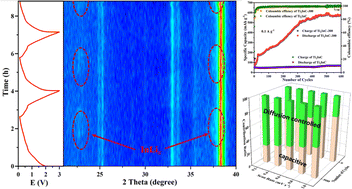Lithium storage performance and mechanism of nano-sized Ti2InC MAX phase†
Abstract
Fine powders of MAX phases (a family of layered carbides/nitrides) have been showing great promise in energy storage applications. A feasible method of obtaining nano-sized MAX phase particles is critical to realizing the practical application of the vast MAX phase family in more technologically important fields. Herein, ball milling, a commercial and feasible method, is employed to prepare nano-sized Ti2InC, which delivers a high specific capacity of 590 mA h g−1 after 500 cycles and maintains 574.4 mA h g−1 after 600 cycles at 0.1 A g−1 when used as a lithium storage anode. Compared with other methods (e.g., partial etching), decreasing the size of Ti2InC particles by ball milling can preserve the exfoliated indium (In) atoms, which have great volumetric and gravimetric capacities. In situ XRD analysis indicates that the capacity of the nano-sized Ti2InC primarily comes from the lithiation of elemental In exfoliated from Ti2InC, and in particular, the exfoliated In atoms by ball milling can increase the initial capacity. The lithiation/delithiation cycle can effectively activate and even exfoliate the Ti2InC grains, which accounts for the increasing capacity upon cycling.

- This article is part of the themed collections: New horizons in materials for energy conversion, optics and electronics and Nanoscale Horizons and Nanoscale: Nanomaterials for Energy


 Please wait while we load your content...
Please wait while we load your content...